torque CHEVROLET EXPRESS 1996 1.G Owners Manual
[x] Cancel search | Manufacturer: CHEVROLET, Model Year: 1996, Model line: EXPRESS, Model: CHEVROLET EXPRESS 1996 1.GPages: 376, PDF Size: 18.83 MB
Page 81 of 376
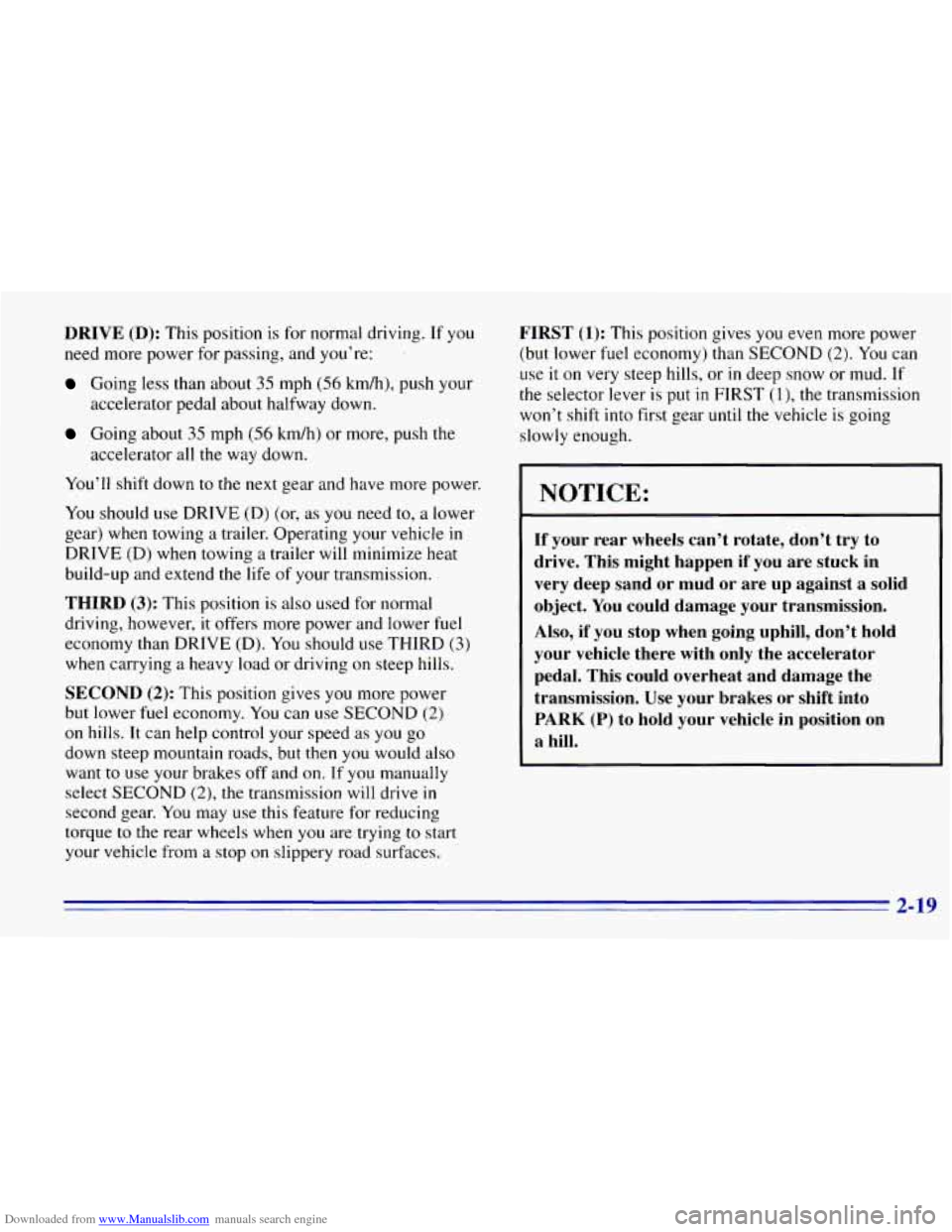
Downloaded from www.Manualslib.com manuals search engine DRIVE (D): This position is for normal driving. If you
need more power for passing, and you’re:
Going less than about 35 mph (56 km/h), push your
accelerator pedal about halfway down.
Going about 35 mph (56 kdh) or more, push the
accelerator all the way down.
You’ll
shift down to the next gear and have more power.
You should use DRIVE (D) (or, as
you need to, a lower
gear) when towing a trailer. Operating your vehicle
in
DRIVE (D) when towing a trailer will minimize heat
build-up and extend
the life of your transmission.
THIRD (3): This position is also used for normal
driving, however,
it offers more power and lower fuel
economy than DRIVE
(D). You should use THIRD (3)
when carrying a heavy load or driving on steep hills.
SECOND (2): This position gives you more power
but lower fuel economy.
You can use SECOND (2)
on hills. It can help control your speed as you go
down steep mountain roads, but then you would also
want to use your brakes off and on. If you manually
select SECOND
(2), the transmission will drive in
second gear. You may use this feature for reducing
torque
to the rear wheels when you are trying to start
your vehicle from a stop
on slippery road surfaces.
FIRST (1): This position gives you even more power
(but lower fuel economy) than SECOND
(2). You can
use it
on very steep hills, or in deep snow or mud. If
the selector lever is put in FIRST (l), the transmission
won’t shift into first gear until the vehicle is going
slowly enough.
NOTICE: -- --
If your rear wheels can’t rotate, don’t try to
drive. This might happen if you are stuck in
very deep sand or mud or are up against a solid
object. You could damage your transmission.
Also, if you stop when going uphill, don’t hold
your vehicle there with only the accelerator
pedal. This could overheat and damage the
transmission. Use your brakes
or shift into
PARK (P) to hold your vehicle in position on
a hill.
2-19
Page 85 of 376
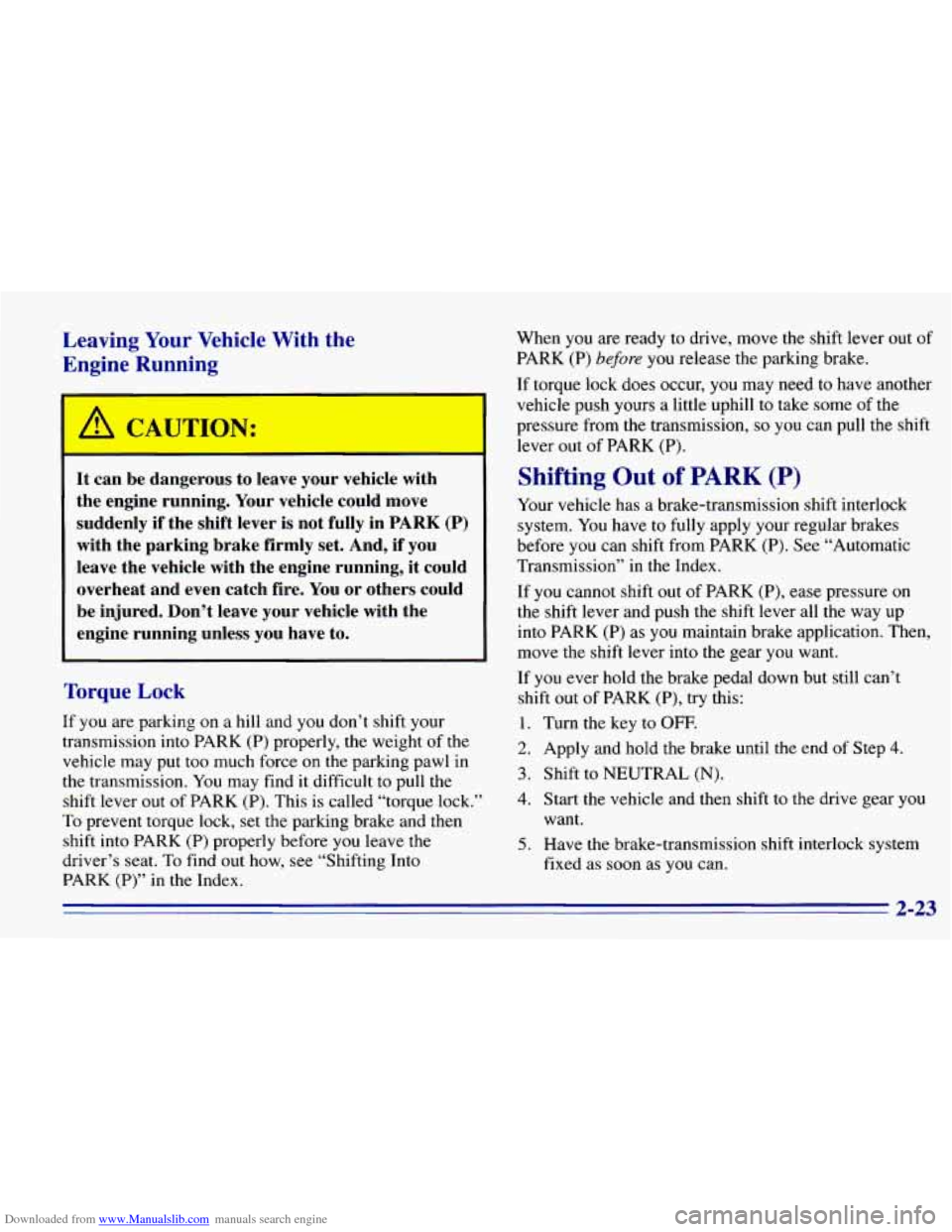
Downloaded from www.Manualslib.com manuals search engine Leaving Your Vehicle With the
Engine Running
A CAUTION:
It can be dangerous to leave your vehicle with
the engine running. Your vehicle could move
suddenly if the shift lever is not fully in
PARK (P)
with the parking brake firmly set. And, if you
leave the vehicle with the engine running, it could
overheat and even catch fire. You or others could
be injured. Don’t leave your vehicle with the
engine running unless you have to.
Torque Lock
If you are parking on a hill and you don’t shift your
transmission
into PARK (P) properly, the weight of the
vehicle may put too much force
on the parking pawl in
the transmission. You may find it difficult to pull the
shift lever
out of PARK (P). This is called “torque lock.”
To prevent torque lock, set the parking brake and then
shift
into PARK (P) properly before you leave the
driver’s seat. To find
out how, see “Shifting Into
PARK
(P)” in the Index. When
you are
ready to drive, move the shift lever out of
PARK (P) before you release the parking brake.
If torque lock does occur,
you may need to have another
vehicle push yours a little uphill
to take some of the
pressure from the transmission, so you can pull the shift
lever out
of PARK (P).
Shifting Out of PARK (P)
Your vehicle has a brake-transmission shift interlock
system. You have to fully apply your regular brakes
before you can shift from PARK (P). See “Automatic
Transmission”
in the Index.
If you cannot shift
out of PARK (P), ease pressure on
the shift lever and push the shift lever all the way up
into PARK (P) as you maintain brake application. Then,
move the shift lever into
the gear you want.
If
you ever hold the brake pedal down but still can’t
shift out
of PARK (P), try this:
1. Turn the key to OFF.
2. Apply and hold the brake until the end of Step 4.
3. Shift to NEUTRAL (N).
4. Start the vehicle and then shift to the drive gear you
5. Have the brake-transmission shift interlock system
want.
fixed
as soon as you can.
2-23
Page 224 of 376
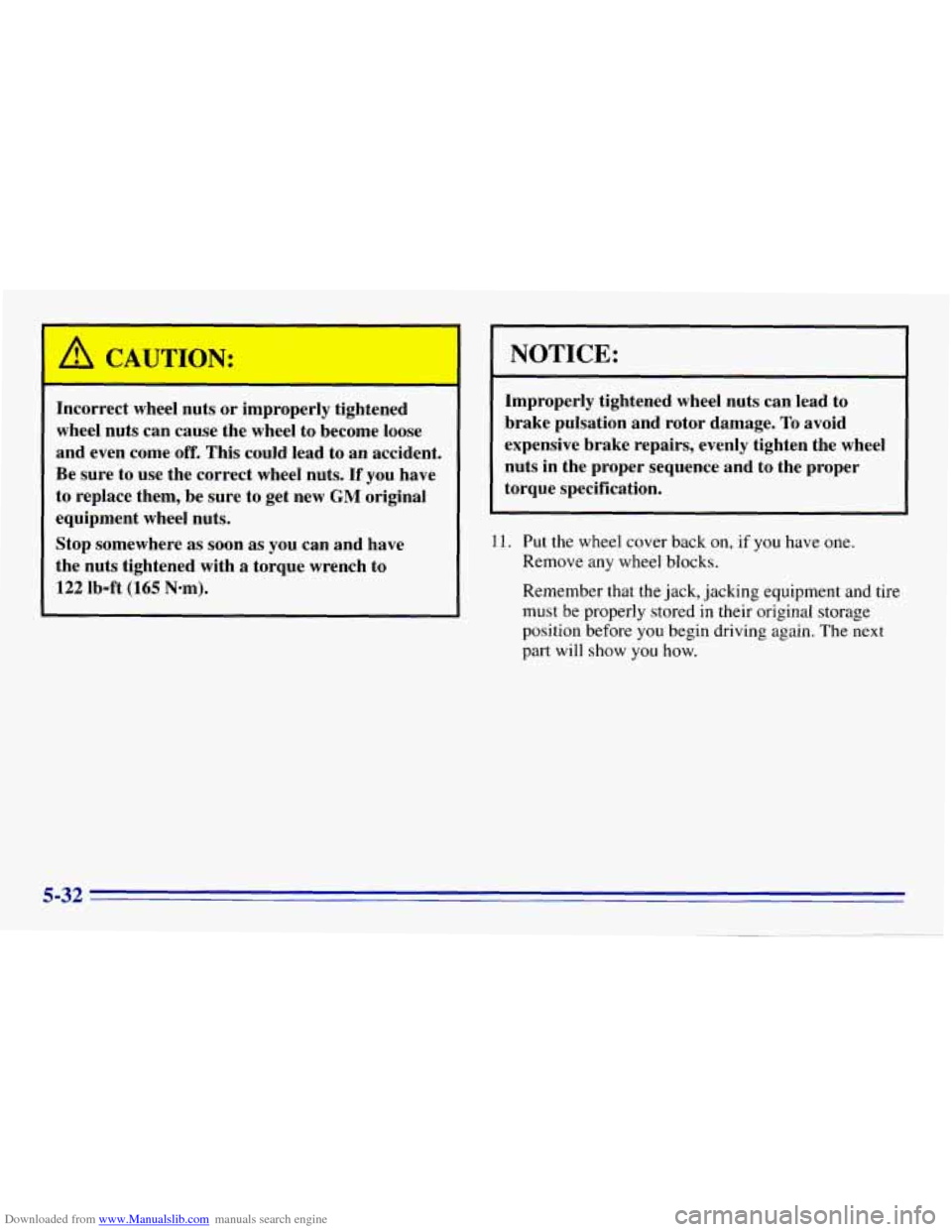
Downloaded from www.Manualslib.com manuals search engine A CAUTION:
Incorrect wheel nuts or improperly tightened
wheel nuts can cause the wheel to become loose
and even come
off. This could lead to an accident.
Be sure to use the correct wheel nuts. If you have
to replace them, be sure to get new
GM original
equipment wheel nuts.
Stop somewhere as soon as you can and have
the nuts tightened with
a torque wrench to
122 lb-ft (165 Nom).
NOTICE:
Improperly tightened wheel nuts can lead to
brake pulsation and rotor damage.
To avoid
expensive brake repairs, evenly tighten the wheel
nuts in the proper sequence and to the proper
torque specification.
11. Put the wheel cover back on, if you have one.
Remove any wheel blocks.
Remember that the jack, jacking equipment and tire
must be properly stored in their original storage
position before
you begin driving again. The next
part will show you how.
5-32
Page 257 of 376
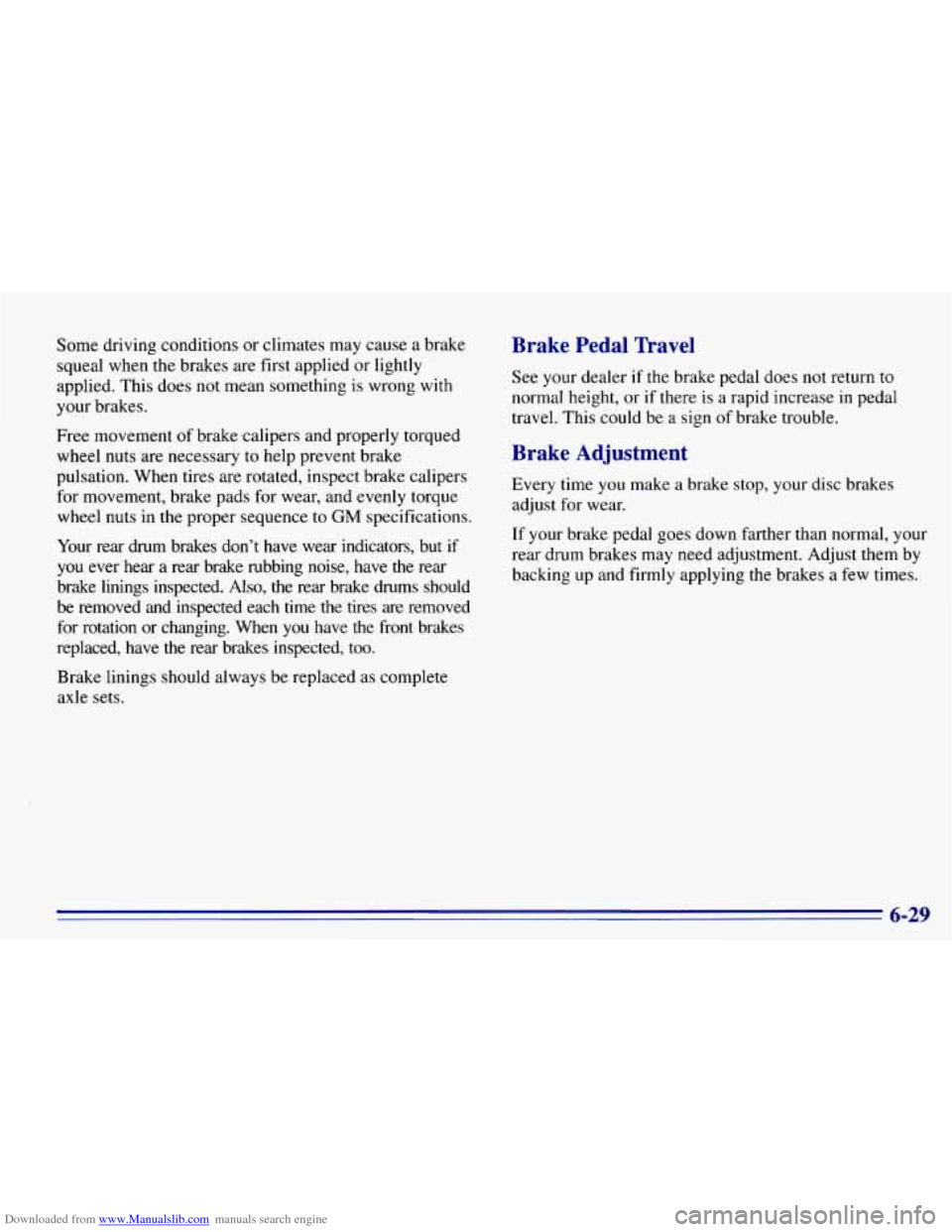
Downloaded from www.Manualslib.com manuals search engine Some driving conditions or climates may cause a brake
squeal when the brakes are first applied
or lightly
applied. This does not mean something is wrong with
your brakes.
Free movement
or Drake calipers and properly torqued
wheel nuts
are necessary to help prevent brake
pulsation. When tires are rotated, inspect brake calipers
for movement, brake pads for wear, and evenly torque
wheel nuts in the proper sequence
to GM specifications.
Your rear drum brakes don’t have wear indicators, but if
you ever hear
a rear brake rubbing noise, have the rear
brake linings inspected. Also, the rear brake drums should
be removed and inspected each time the tires are removed
for rotation or changing. When
you have the front brakes
replaced, have the rear brakes inspected,
too.
Brake linings should always be replaced as complete
axle sets.
Brake Pedal Travel
See your dealer if the brake pedal does not return to
normal height, or if there is a rapid increase in pedal
travel. This could be a sign of brake trouble.
Brake Adjustment
Every time you make a brake stop, your disc brakes
adjust for wear.
If your brake pedal goes down farther than normal, your
rear drum brakes may need adjustment. Adjust them by
backing up and firmly applying the brakes
a few times.
6-29
Page 271 of 376
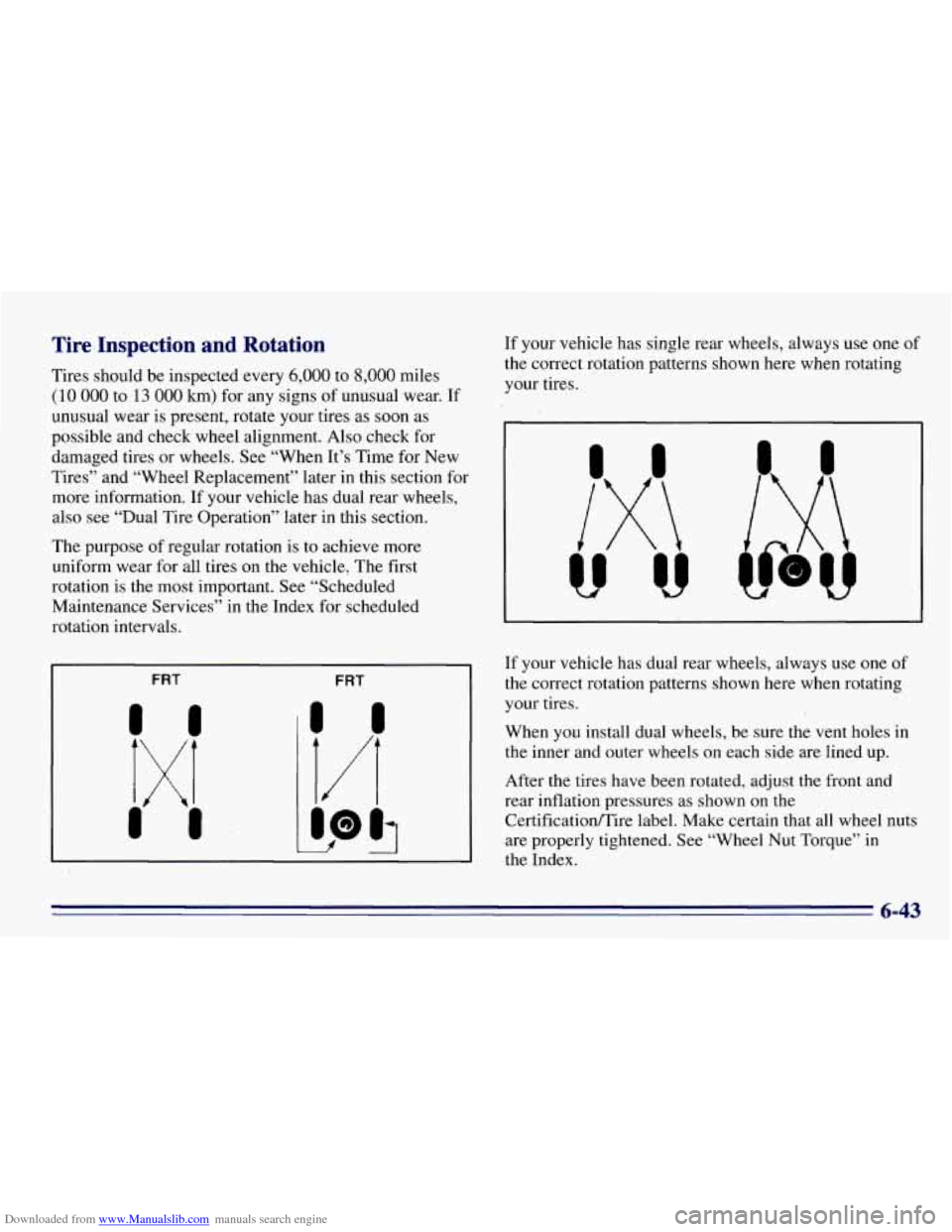
Downloaded from www.Manualslib.com manuals search engine Tire Inspection and Rotation
Tires should be inspected every 6,000 to 8,000 miles
(10 000 to 13 000 km) for any signs of unusual wear. If
unusual wear is present, rotate your tires as soon as
possible and check wheel alignment. Also check for
damaged tires or wheels. See “When It’s Time for New
Tires” and “Wheel Replacement” later in this section for
more information. If your vehicle has dual rear wheels,
also see “Dual Tire Operation’’ later in this section.
The purpose of regular rotation is to achieve more
uniform wear for all tires on the vehicle: The first
rotation is the most important. See “Scheduled
Maintenance Services” in the Index for scheduled
rotation intervals.
I FRT FRT
If your vehicle has single rear wheels, always use one of
the correct rotation patterns shown here when rotating
your tires.
II
If your vehicle has dual rear wheels, always use one of
the correct rotation patterns shown here when rotating
your tires.
When you install dual wheels, be sure the vent holes in
the inner and outer wheels on each side are lined
up.
After the tires have been rotated, adjust the front and
rear inflation pressures as shown on the
Certificationmire label. Make certain that all wheel nuts
are properly tightened. See “Wheel Nut Torque’’ in
the Index.
6-43
Page 273 of 376
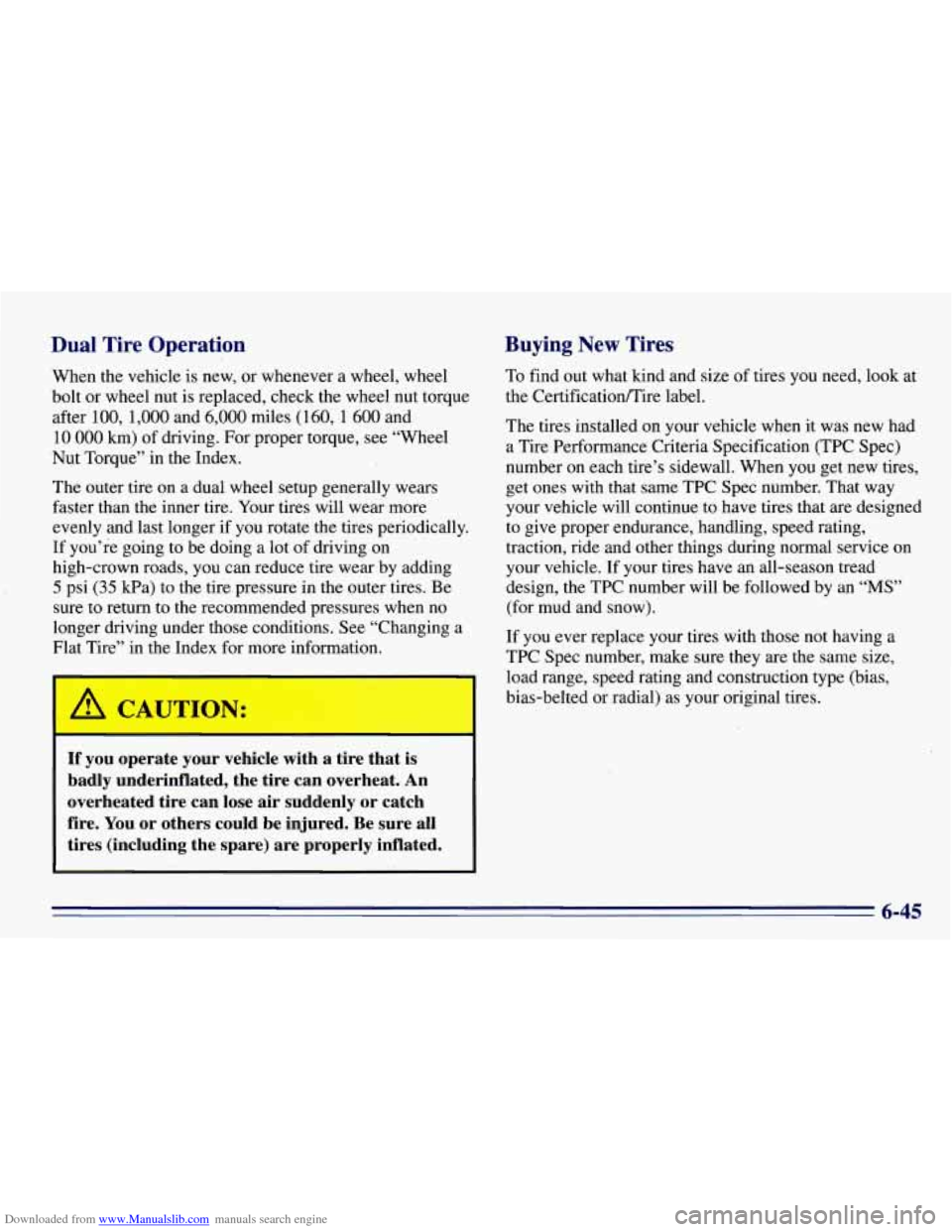
Downloaded from www.Manualslib.com manuals search engine Dual Tire Operation Buying New Tires
To
find out what kind and size of tires you need, look at
the Certificatioflire label.
When
the vehicle is new, or whenever a wheel, wheel
bolt or wheel nut is replaced, check the wheel nut torque
after
100, 1,000 and 6,000 miles (160, 1 600 and
10 000 km) of driving. For proper torque, see “Wheel
,Nut Torque” in the Index.
The outer tire on a dual wheel setup generally wears
faster than the inner tire. Your tires will wear more
evenly and last longer if you rotate the tires periodically.
If you’re going to be doing a lot of driving on
high-crown roads, you can reduce tire wear by adding
5 psi (35 kPa) to the tire pressure in the outer tires. Be
sure to return to the recommended pressures when no
longer driving under those conditions. See “Changing a
Flat Tire” in the Index for more information. The tires installed on your
vehicle when it was new had
a Tire Performance Criteria Specification (TPC Spec)
number on each tire’s sidewall. When you get new tires,
get ones with that same TPC Spec number. That way
your vehicle will continue to have tires that are designed
to give proper endurance, handling, speed rating,
traction, ride and other things during normal service on
your vehicle. If your tires have an all-season tread
design, the TPC number will be followed by an
“MS”
(for mud and snow).
11 you ever replace your tires with those not having a
TPC Spec number, make sure they are the same size,
load range, speed rating and construction type (bias,
bias-belted or radial) as your original tires.
If you operate your vehicle with a tire that is
badly underinflated, the tire can overheat. An
overheated tire can lose air suddenly or catch
fire.
You or others could be injured. Be sure all
tires (including the spare) are properly inflated.
6-45
Page 277 of 376
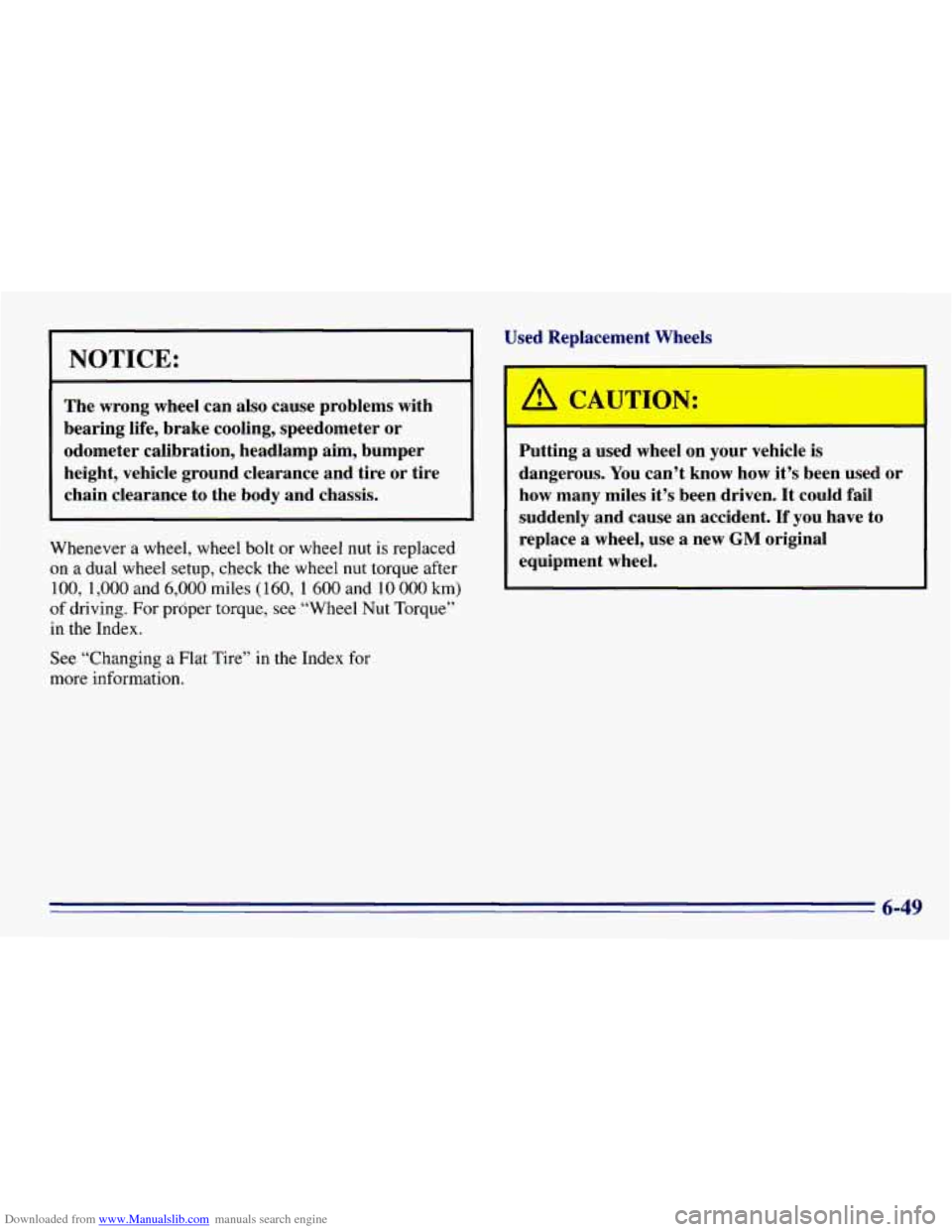
Downloaded from www.Manualslib.com manuals search engine NOTICE:
The wrong wheel can also cause problems with
bearing life, brake cooling, speedometer or
odometer calibration, headlamp aim, bumper
height, vehicle ground clearance and tire or tire
chain clearance to the body and chassis.
Whenever a wheel, wheel bolt or wheel nut is replaced
on a dual wheel setup, check the wheel
nut torque after
100, 1,000 and 6,000 miles (160, 1 600 and 10 000 km)
of driving. For proper torque, see “Wheel Nut Torque”
in the Index.
See “Changing a Flat Tire”
in the Index for
more information.
Used Replacement Wheels
Putting a used wheel on your vehicle
is
dangerous. You can’t know how it’s been used or
how many miles it’s been driven. It could fail
suddenly and cause an accident.
If you have to
replace
a wheel, use a new GM original
equipment wheel.
6-49
Page 293 of 376
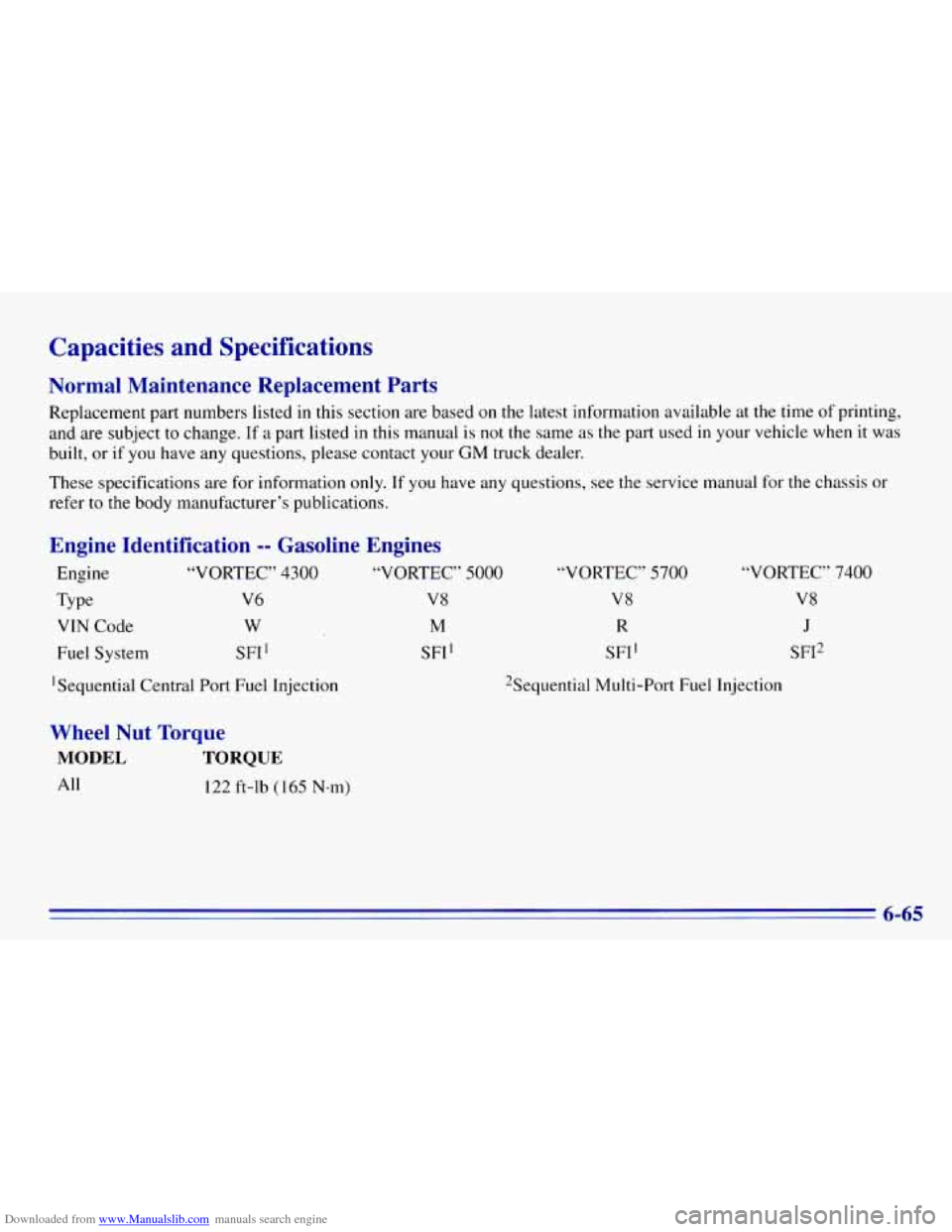
Downloaded from www.Manualslib.com manuals search engine Capacities and Specifications
Normal Maintenance Replacement Parts
Replacement part numbers listed in this section are based on the latest information available at the time of printing,
and are subject to change.
If a part listed in this manual is not the same as the part used in your vehicle when it was
built, or if you have any questions, please contact your GM truck dealer.
These specifications are for information
only. If you have any questions, see the service manual for the chassis or
refer to the body manufacturer’s publications.
Engine Identification -- Gasoline Engines
Type V6 V8
Engine
“VORTEC” 4300
“VORTEC” 5000
VIN Code w M
Fuel System SFI’ SFI
Sequential Central Port Fuel Injection
Wheel Nut Torque
MODEL TORQUE
All 122 ft-lb ( 165 N-m)
“VORTEC” 5700
V8
R
SFI’
2Sequential Multi-Port Fuel Injection “VORTEC”
7400
V8
J
SFI~
L LC
Page 343 of 376
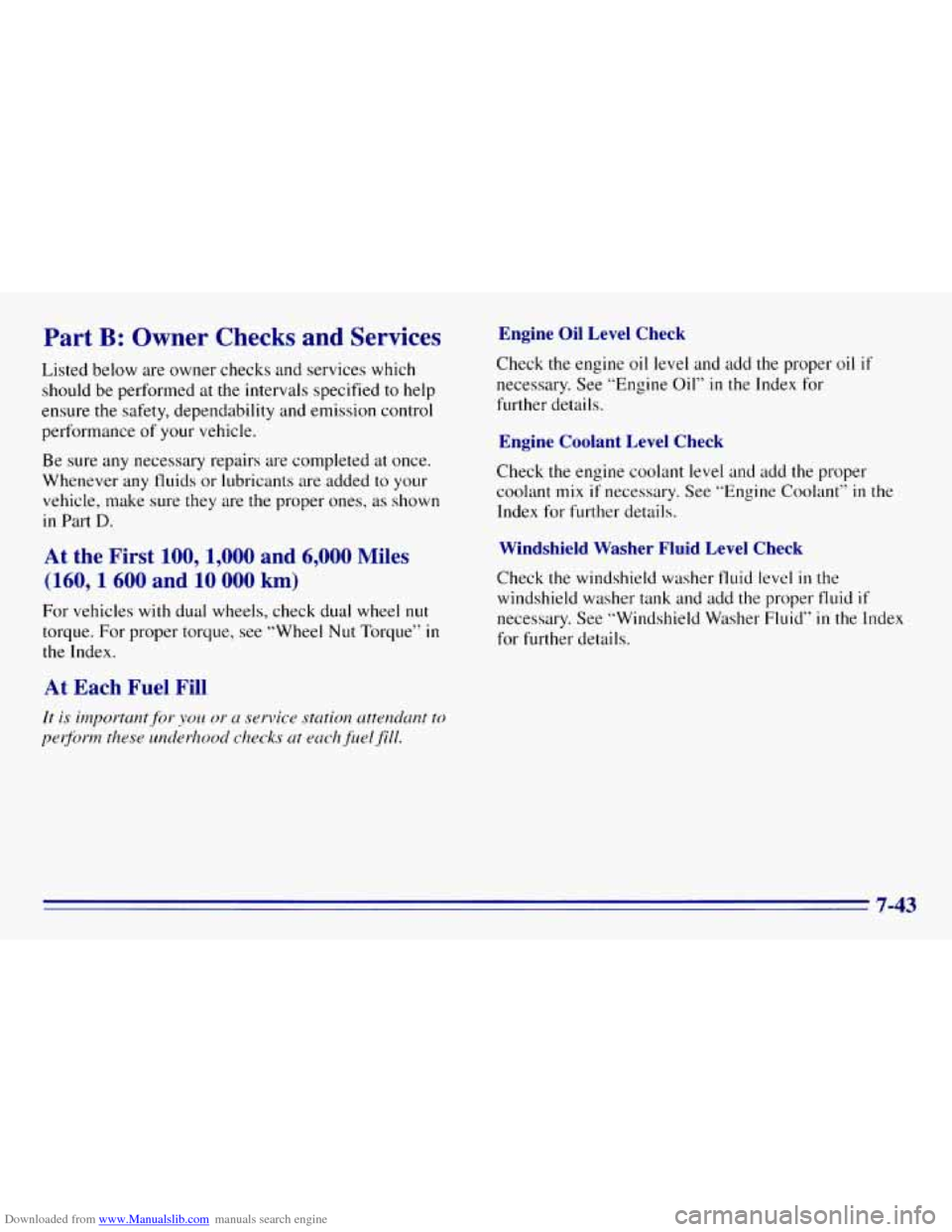
Downloaded from www.Manualslib.com manuals search engine Part B: Owner Checks and Services
Listed below are owner checks and services which
should be performed at the intervals specified to help
ensure
the safety, dependability and emission control
performance
of your vehicle.
Be sure any necessary repairs are completed at once.
Whenever any fluids or lubricants are added to your
vehicle, make sure
they are the proper ones, as shown
in Part
D.
At the First 100, 1,000 and 6,000 Miles
(160,1600 and 10 000 km)
For vehicles with dual wheels, check dual wheel nut
torque. For proper torque, see “Wheel Nut Torque” in
the Index.
At Each Fuel Fill
Engine Oil Level Check
Check the engine oil level and add the proper oil if
necessary. See “Engine Oil” in the Index .for
further details.
Engine Coolant Level Check
Check the engine coolant level and add the proper
coolant
mix if necessary. See “Engine Coolant” in the
Index for further details.
Windshield Washer Fluid Level Check
Check the windshield washer fluid level in the
windshield washer tank and add
the proper fluid if
necessary. See ”Windshield Waher Fluid” in the Index
for further details.
7-43
Page 373 of 376
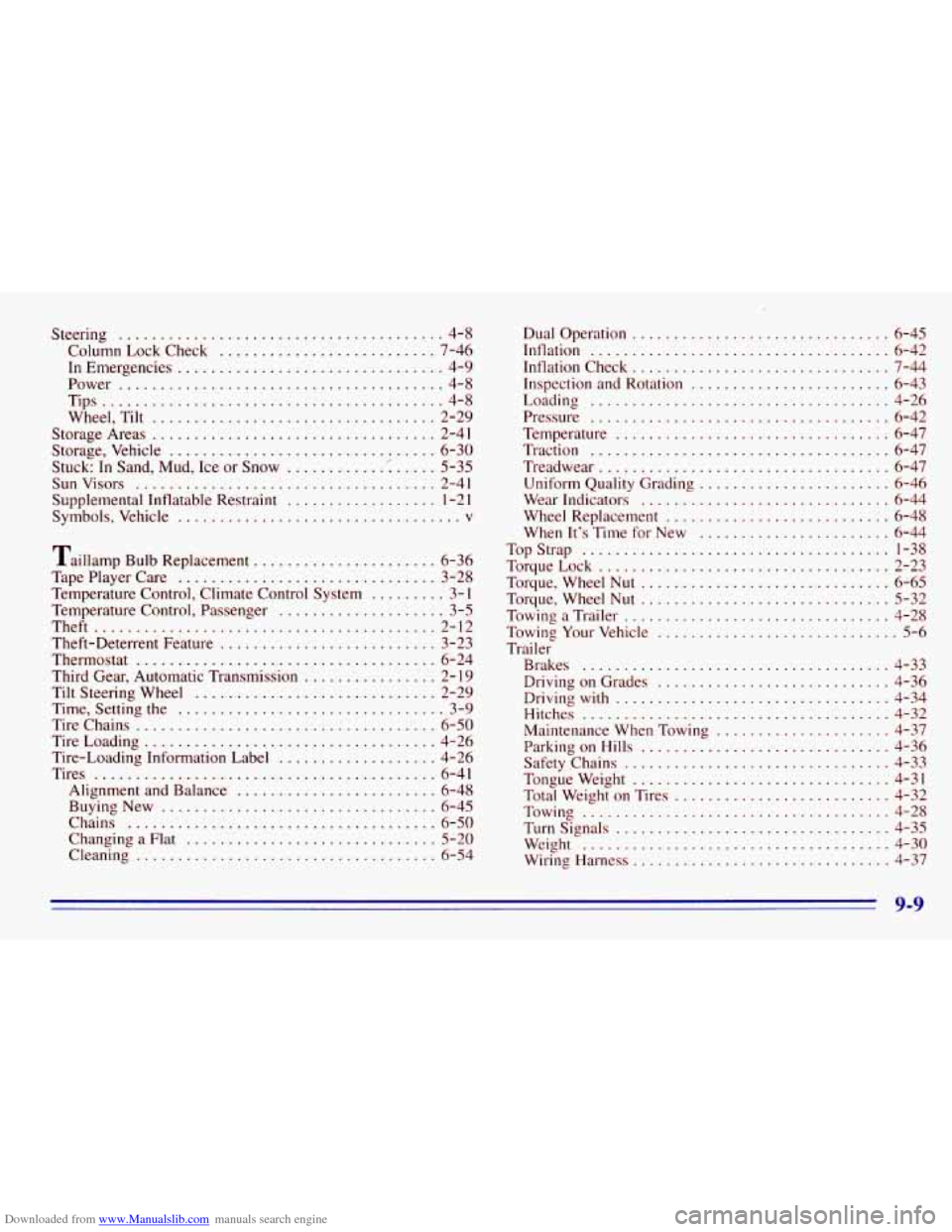
Downloaded from www.Manualslib.com manuals search engine Steering ....................................... 4-8
Column Lock Check
.......................... 7-46
In Emergencies
................................ 4-9
Power
....................................... 4-8
Tips
......................................... 4-8
Wheel. Tilt
.................................. 2-29
StorageAreas
.................................. 2-41
Storage. Vehicle
................................ 6-30
Stuck: In Sand. Mud. Ice or Snow
............ ". ..... 5-35
SunVisors
.................................... 2-41
Supplemental Inflatable Restraint
.................. 1-2 1
Symbols, Vehicle .................................. v
Taillamp Bulb Replacement ...................... 6-36
Tape Player Care
............................... 3-28
Temperature Control. Climate Control System
......... 3- 1
Temperature Control. Passenger .................... 3-5
Theft
......................................... 2-12
Theft-Deterrent Feature
.......................... 3-23
Thermostat
.................................... 6-24
Third Gear. Automatic Transmission
................ 2- 19
Tilt Steering Wheel
............................. 2-29
Time. Setting the
................................ 3-9
Tire Chains
.................................... 6-50
TireLoading ................................... 4-26
Tire-Loading Information Label
................... 4-26
Tires
......................................... 6-41
Alignment and Balance
........................ 6-48
Buying New
................................. 6-45
Chains
..................................... 6-50
Changing
a Flat .............................. 5-20
Cleaning
.................................... 6-54
Dual Operation ............................... 6-45
Inflation
.................................... 6-42
Inflation Check
............................... 7-44
Inspection and Rotation
........................ 6-43
Loading
.................................... 4-26
Pressure
.................................... 6-42
Temperature
................................. 6-47
Traction
.................................... 6-47
Treadwear
................................... 6-47
Uniform Quality Grading
....................... 6-46
Wear Indicators
.............................. 6-44
Wheel Replacement
........................... 6-48
When It's Time for New
....................... 6-44
TopStrap
..................................... 1-38
TorqueLock
................................... 2-23
Torque. Wheel
Nut .............................. 6-65
Torque. Wheel
Nut .............................. 5-32
TowingaTrailer
................................ 4-28
Trailer Towing Your Vehicle
............................. 5-6
Brakes
..................................... 4-33
Driving on Grades
............................ 4-36
Driving
with ................................. 4-34
Hitches
..................................... 4-32
Maintenance When Towing ..................... 4-37
Parking on Hills
.............................. 4-36
Safety Chains
................................ 4-33
Tongueweight
............................... 4-31
Total Weight on Tires
.......................... 4-32
Towing
..................................... 4-28
Weight
..................................... 4-30
Wiring Harness
............................... 4-37
Turnsignals
................................. 4-35
9-9